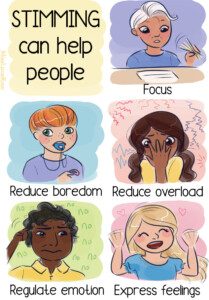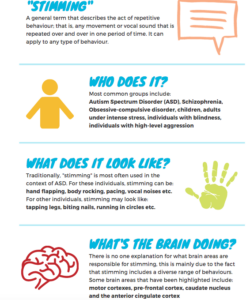Don’t understand why autistic people need to stim so much? You WILL after reading what 10 autistic adults have to say.
Ahhh stimming: What autistic individual could go a short period without? We love our stimming behaviors.
The most self-sufficient, take-charge autistic adult may still find himself or herself stimming throughout the day.
I never realized just how much I stimmed until I began my ASD diagnosis journey.
Stimming doesn’t necessarily mean we’re neurotic, a Nervous Nellie or Edgy Eddie, apprehensive or struggling with anxiety.
Yes, anxiety, boredom or trepidation can bring out an autistic person’s stims, but often, stimming is done for unrelated reasons.
The First Reason Autistics Stim: Completion
Wherever I am in space, time and task at hand — the picture isn’t complete unless it includes stimming.
Stimming “completes” my existence. When I say existence I don’t mean in the philosophical sense.
I mean at any given moment, in time and space, whatever I’m doing. At any second, I’m in existence.
And sometimes, that existence just doesn’t feel complete or whole unless there’s stimming.
The existence needs a component of release. Stimming provides the release.
To NOT stim means to hold back or suppress. And the sensation of holding something back is not comfortable.
Stimming is the last element of any given moment of existence to make it whole — thorough — a finished product.
It usually starts subconsciously; I may not even be aware of it. There are times when I’ll suddenly realize I’ve been stimming for an extended period.
However, some stims occur more deliberately or consciously.
For some people on the Spectrum, a stim may involve a “fidget” (gadget), a “stim toy” or a common object such as a pen, paper clip, coin or their necklace.
This can still occur subconsciously; the Autist grabs the beaded bracelet or swath of velvet on their lap while reading and begins “fiddling” with it.
I usually don’t know precisely when a stim starts up. However, in public, they’re subdued: mini-stims such as repeatedly curling my toes, tapping a finger on a leg, clasping my hands and squeezing in pulses, rubbing a finger over and over against the opposite hand, going up and down on a foot while seated, tensing and non-tensing my calve muscles, or flapping a foot while my legs are crossed.
The Second Reason Autistic People Stim
For me, standing still isn’t comfortable. I’d rather walk briskly than stand still in one spot.
But if I’m confined to one spot or am waiting in line, the only way I can move is to stim.
Thus, it’s possible that for some autistic people, stimming is done because being perfectly still, even when seated, just isn’t comfortable.
Dis-ease with stillness isn’t necessarily related to mood.
I can be very content and at peace while seated on my favorite sofa and still find stillness uninviting.
Something has to keep moving! When seated, one of my most common stims is rocking.
Yes, rocking – that proverbial repetitive movement forever associated with severely impaired people. But it’s so self-regulating! However, I do it only in private.
You’ve probably heard that the human body was meant to move, to be active.
Maybe in autistic people, this hardwired trait is on overdrive. This doesn’t mean there aren’t times I’m immobile while in private. I can be.
But usually, something’s moving while I’m seated. It can be as subtle as a little toe wiggling or intertwining my fingers and repeatedly pressing a thumb to the opposite bottom joint of my index finger; or, my fourth fingernail repeatedly rubs back and forth on the fleshy part of my palm.

MissLunaRose12, CC BY-SA 4.0 creativecommons.org/licenses/by-sa/4.0 Wikimedia Commons
What’s in a Stim? Nine More Autistic Adults Explain

Cutting paper over and over can be a stimming behavior for self-regulation or even sensory joy. ©Lorra Garrick
“When I am fatigued but still in a meeting, I do start to sway and bounce,” says Brad Biren, a tax and elder law attorney with a specialty in crisis Medicaid planning, who was diagnosed with autism at 35.
“Stimming tends to begin without purposeful intent, but at some point, at least for me, I do realize what I am doing and then intentionally decide to continue.
“I decide to continue rocking or swaying because it helps me to cope with stressors like fatigue.
“Why do I stim? Imagine a sense of flight, as in fight or flight, palpably growing within you.
“Then you start to lose concentration, all the while, that sense of fear or stress is increasing.
“Then it just kind of happens or starts. My stimming tends to be swaying, pacing, standing, jumping.
“I did not hand flap [when younger], but I would bite my nails and fingertips until they bled almost daily. This compulsion was assumed to be a ‘bad habit’ rather than an indicator of ASD.
“In hindsight the feelings were identical. I felt crushing anxiety and at times overwhelming joy — both of which caused stimming.”
Victoria Jones, an educator and entrepreneur, was diagnosed autistic at 30.
She explains, “I stim because it feels good and lowers my anxiety. It comes as naturally to me as breathing, and I’ve accepted it as a normal part of my existence.”
Darren Turner, 36, who runs a product review site, was diagnosed with autism at 33.
He explains, “I stim when I’m either highly stressed or excited; it’s my way of releasing that emotion without having to explain what it is I’m feeling.
“I hand flap and flick my fingers about at the same time when I’m excited about something, and when I’m stressed I sometimes rock backward and forward in my office chair.
“The motion helps relieve the stress feelings. I also use a fidget toy when I need to concentrate on something or when I’m writing a piece on my website.
“The distraction enables me to concentrate more and makes me more productive.”
Katie Santoro is 26, an autism advocate and was diagnosed at 24.
“Stimming is a way to regulate my mind and body,” she says.
“Stimming can help me find balance in a world that can sometimes seem loud, busy or generally overwhelming.
“I have a stand-up swing inside my studio apartment. I like using my swing to rock back and forth.
“I have a skylight that I can turn on in my room. The skylight is a form of visual stimming, which is a common form within the autism spectrum.”
Jason San Souci helps autistic people find jobs in the burgeoning drone industry.
Diagnosed with autism at 42, he says, “I tap my nose rapidly with both hands. The hand flapping (rapid tapping) on my nose is an involuntary response to excitement.
Demi Rivera, who runs a hair salon, says, “I need to stim to get rid of excess anxiety energy.” She’s 28 and was diagnosed with autism at 25.
“Bouncing my leg while I am sitting and listening to a teacher or typing an email on my computer actually helps me process information and focus way better.
“The things we do that may cause alarm or seem strange are actually small methods that help us regain a sense of grounding and baseline.
“Sometimes I refer to movement stims as ‘getting the wiggles out,’ which I need to do multiple times a day.”
Jess Owen is co-creator of thewyrdsisters.co.uk and was diagnosed with ASD at 25.
“When I’m anxious or excited, stimming seems to match the energy of my brain,” she says.
“If I experience any heightened emotion — positive or negative — then my mind starts running at a hundred miles an hour, and it seems unnatural for my hands to be doing nothing to reflect this.
“Also in the case of anxiety or similar negative feelings, stimming can provide a comforting distraction (for example, I stim subtly during stressful work calls to distract from the call itself).”
Justin Donne is a businessman who was diagnosed with autism at 34. He explains, “Stimming is important to me because it’s almost like meditating.
“It draws my attention in, and away from whatever is distressing me outside.
“I can sometimes actually get in ‘the zone’ and focus more while stimming. Other times it’s just a relief.”
Flamboyant Stimming
A stim that I’ve perhaps done hundreds of times in a single day is clicking my teeth together. Nobody can see or hear this.
But its discreet nature doesn’t make it any less of a stim, or any more “high-functioning” of a stim, than hand flapping, rocking, spinning, humming or swinging the arms about.
A person with pronounced autism (Level 3) may quite elaborately stim in public.
A person with zero to minimal support needs (Level 1) may still be flamboyant with the regulating behavior – but usually confines their more dynamic or aggressive movements to private, replacing them in public with smaller, less obvious repetitive behaviors.
One of my stims does occur on a conscious level: sniffing and feeling my hair. I do this for the sheer enjoyment but also to help focus when researching topics online.
When I’m at my computer, I’m aware of when I grab a swath of my lush hair and press it to my lower face, covering it completely like a covid mask does. And I inhale deeply. Mmmmm! Heaven!
I feel its extremely unique texture against my skin. I may hold it against my face for several minutes, inhaling its sweet scent with each breath.
I may rapidly inhale in short sniffs and exclaim, “MMM!” I’m very aware of when I start this stimming process and when I finish. It may even be accompanied by a little rocking: double stimming!
Stimming Gadgets

Many Autistics seek out self-regulation with inanimate objects such as squeezable balls and spinner fidgets.
I don’t stim with objects other than my hair. However, the gentle chewing I do on my tongue (gliding my back upper teeth down on it) is as much an autistic stim as is someone repetitively chewing on a fidget necklace or “chewelry.”
Sometimes while at the computer or watching TV, my fingertips are between my lips or even in my mouth.
My teeth may comfortably sustain mobile contact with a fingernail. I may also repeatedly press my fingertips above my upper lip.
I NEVER do any of this around people. This activity seems to help me focus when at the computer.
I don’t nibble at my nails, though (I keep them nice-looking), but nevertheless, finger to mouth activity has that stereotypical juvenile appearance.
But nibbling at a necklace may have a more “refined” or “upgraded” look.
“I sell these Acupressure Rings in my online store and I use those daily,” says Ashley Lauren Spencer, who’s autistic, and owner of The Autistic Innovator, an online store for autistic adults and author of Resources for Autistic Adults: Volume 1.
“If I’m super anxious, I’ll put one on my finger and roll it up and down, switching fingers occasionally.
“Stimming also helps me focus on what I’m doing, whether it’s a conversation or thinking of a new business idea.
“Physically, it feels like I carry a lot of excess energy in my hands, and when I stim, it sort of releases that excess energy.
“I’ve also been using the Glitter Stim Ring from my store since June 2021, and after 11 months of wearing it, I’ve officially worn it down. It held up for a long time.
“Before the acupressure rings, I would spin the stim ring on my thumb to fidget when my hands were clasped together out in public.
“It was a way of releasing that anxious energy, especially when I had a stim ring on each hand.”
- Spiky Acupressure Rings: shop.autisticinnovator.com/products/spiky-acupressure-rings-5-pack-autism
- Glitter Spinner Stim Ring: shop.autisticinnovator.com/products/glitter-spinner-stim-ring
The Irony of Neurotypicals Thinking Our Stims Are “Weird”
Yeah, OUR self-regulating, self-calming and tension-relieving repetitive behaviors are weird, while you neurotypicals strive to achieve the exact same results by smoking and drinking!
Granted, some autistic people smoke and drink to relieve stress or for a calming effect.
But I wonder how many NTs — who light up a cigarette in response to a stimulus, or who have a few drinks first chance they get after work – think it’s weird or a sign of “low functioning” when an autistic person rocks, spins about, goes up and down on the balls of their feet, chews on or finger-fiddles with stimming toys, or engages in the proverbial hand flapping!
That hand flapper could be the guy who drives to his job as a high school English teacher.

U3173480, CC BY-SA 4.0 creativecommons.org/licenses/by-sa/4.0 Wikimedia Commons
 Brad Biren, Esq, LL.M, specializes in assisting individuals with special needs and diverse talents who are overcoming sudden adversity. He utilizes his inspiring tale of overcoming unexpected adversity to help motivate others in the community to pursue their goals.
Brad Biren, Esq, LL.M, specializes in assisting individuals with special needs and diverse talents who are overcoming sudden adversity. He utilizes his inspiring tale of overcoming unexpected adversity to help motivate others in the community to pursue their goals.
 Darren Turner runs a website, myhelpfulhints.co.uk, where you can find honest, unbiased product reviews.
Darren Turner runs a website, myhelpfulhints.co.uk, where you can find honest, unbiased product reviews.

Katie Santoro is a junior board member for Unicorn Children’s Foundation, dedicated to creating cradle to career pathways for children and young adults with developmental differences. Katie is also involved with the Center for Autism and Related Disorders. @autistic.thegreeklife
 Jason San Souci is an autistic drone scientist. He is a graduate of the USAF Academy with a master’s of engineering from the University of Colorado. His mission is to elevate the drone industry through thought leadership and neurodiversity advocacy.
Jason San Souci is an autistic drone scientist. He is a graduate of the USAF Academy with a master’s of engineering from the University of Colorado. His mission is to elevate the drone industry through thought leadership and neurodiversity advocacy.
 Victoria Jones is an educator and the founder of Curriculum & Culture. She is passionate about sharing her love of books with students and inspiring them to develop an authentic love.
Victoria Jones is an educator and the founder of Curriculum & Culture. She is passionate about sharing her love of books with students and inspiring them to develop an authentic love.
 Demi Rivera, a licensed cosmetologist, owns and operates Talking Hairs, a Denver, CO hair salon that accommodates autistic, other neurodivergent and neurotypical adults and children. Demi makes accommodations to fit each client’s individual sensory needs. Follow her on Instagram: @talking_hairs.
Demi Rivera, a licensed cosmetologist, owns and operates Talking Hairs, a Denver, CO hair salon that accommodates autistic, other neurodivergent and neurotypical adults and children. Demi makes accommodations to fit each client’s individual sensory needs. Follow her on Instagram: @talking_hairs.
 Jess Owen, along with her sisters Emily and Abi, run thewyrdsisters.co.uk, about autistic sisters navigating a neurotypical world. Their goal is to spread information and awareness, and open up a conversation about neurodiversity that will make life easier for everyone.
Jess Owen, along with her sisters Emily and Abi, run thewyrdsisters.co.uk, about autistic sisters navigating a neurotypical world. Their goal is to spread information and awareness, and open up a conversation about neurodiversity that will make life easier for everyone.
 Justin Donne is an accomplished leader with experience across private and nonprofit sectors, including roles at Disney Parks & Resorts and Autistic Nottingham. He excels in team leadership, budget management and driving growth. Justin is an advocate for positive change and has a strong belief in the power of community, and is a passionate advocate for diversity, equity and inclusion.
Justin Donne is an accomplished leader with experience across private and nonprofit sectors, including roles at Disney Parks & Resorts and Autistic Nottingham. He excels in team leadership, budget management and driving growth. Justin is an advocate for positive change and has a strong belief in the power of community, and is a passionate advocate for diversity, equity and inclusion.
 The Autistic Innovator was founded by Ashley Lauren Spencer. Ashley Lauren Spencer is an autistic entrepreneur and author. Her focus is encouraging and providing resources for autistic adults, so we can build our best and most authentic life.
The Autistic Innovator was founded by Ashley Lauren Spencer. Ashley Lauren Spencer is an autistic entrepreneur and author. Her focus is encouraging and providing resources for autistic adults, so we can build our best and most authentic life.
 Lorra Garrick has been covering medical, fitness and cybersecurity topics for many years, having written thousands of articles for print magazines and websites, including as a ghostwriter. She’s also a former ACE-certified personal trainer. In spring 2022 she received a diagnosis of Level 1 Autism Spectrum Disorder.
Lorra Garrick has been covering medical, fitness and cybersecurity topics for many years, having written thousands of articles for print magazines and websites, including as a ghostwriter. She’s also a former ACE-certified personal trainer. In spring 2022 she received a diagnosis of Level 1 Autism Spectrum Disorder.
.
Top image: Freepik.com/8photo
Autistic Special Interest vs. Neurotypical Hobby: the Difference?
Can Autism Be Ruled Out if the Patient Has Good Eye Contact?



























